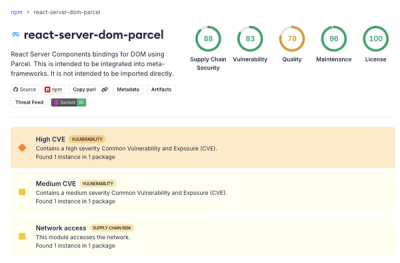Cropduster
Cropduster is a collection of tools for building pages to be web cropped by
Movable Ink.

Installation
Cropduster is on npm. Install it with:
npm install --save-dev cropduster
The use it by importing it from your es6-enabled javascript file:
import CD from 'cropduster';
Legacy Installation
To use Cropduster directly in the browser, loaded from a script tag, you can
find legacy versions at:
http://projects.movableink.com/production/libs/cropduster.[version].js
Where you replace [version] with the version you want to use.
Browser-only cropduster versions are no longer being published for new versions.
API
Asynchronous actions
Sometimes, Capturama needs to be explicitly told to hold off on finishing its
screen capture in order for some asynchronous actions to fire and complete. This
can be accomplished by calling CD.pause when an asynchronous action is about
to start, and CD.resume when it has completed. pause takes a maxSuspension
Number argument specifying the maximum amount of time in milliseconds that your
asynchronous action is allowed to take, and both functions take an optional
final argument of a String message explaining the suspension, purely used for
debugging the Capturama log.
If you are using the Cropduster API for common asynchronous actions like
fetching a URL or an image with CD.get and CD.getImage, or if you are using
Promises directly, you do not need to manually call pause and resume. These
methods are used internally in the necessary places. However, if you are
doing something unusual that requires work to be delayed manually, each call to
CD.pause must have a corresponding call to CD.resume, or the request to
Capturama will eventually time out.
Example:
const target = document.getElementById('text-box');
const customerQuality = CD.param('mi_customer_rating');
const tenSeconds = 10 * 1000;
if (customerQuality === 'very-good') {
target.innerText = 'good customers get images quickly';
} else if (customerQuality === 'very-bad') {
CD.pause(tenSeconds, 'making bad customers wait for their email to load...');
setTimeout(() => {
CD.resume();
target.innerText = 'bad customers have to wait for their images';
}, 1000);
}
It is generally recommended to call CD.pause as the last thing before starting
an asynchronous action, and CD.resume as the very first thing once that action
has finished. If your asynchronous action completes successfully, but your
callback runs some code before calling CD.resume again, then you run the risk of
triggering a JavaScript error that stops execution of the current script. If
CD.resume is not called after that first CD.pause, your image will eventually
time out, as opposed to failing immediately.
NOTE: Cropduster previously offered CD.suspend and CD.capture functions
that achieved a similar goal. These functions have been replaced with pause
and resume, to support a better synchronisation of state with Capturama, and
to give a clearer sense of how these functions affect Capturama's workflow.
Selecting elements
CD.$ is useful for getting an array of DOM elements via a CSS selector. It always returns an array.
Example:
const elements = CD.$('div.items');
for (let i = 0; i < elements.length; i++) {
const element = elements[i];
element.style.display = 'none';
}
or:
const elements = CD.$('div.items');
for (const element of elements) {
element.style.display = 'none';
}
Query params
CD.param retrieves query parameters from the current document's URL. It does not support nested params or arrays of values.
Example:
const fname = CD.param('fname');
console.log(fname);
Fetching third-party resources
Movable Ink's capture engine traditionally captures the web page as soon as the page's ready event fires. This can cause
issues when the user tries to fetch pages via ajax, as the capture engine does not wait for the ajax load to complete
before rendering. In order to delay capture until the request has finished, use CD.get. It temporarily suspends capture
until the request completes. Note: the URL has to be CORS-accessible, see CD.getCORS if it isn't. When in doubt, use CD.getCORS.
Example:
CD.get('http://cors-enabled-site.com/page').then((response) => {
const { data, status, contentType } = response;
CD.$('h1')[0].innerHTML = data.header;
});
Send POST and sending extra headers:
CD.get('http://cors-enabled-site.com/page', {
method: 'POST',
body: '{"ok": "yes"}',
headers: {
'Accept': 'application/json'
}
}).then((response) => {
CD.$('h1')[0].innerHTML = response.data.h1;
})
Fetching third-party resources with CORS
Security restrictions prevent web pages from making cross-domain ajax requests. CORS
is a workaround, but requires support from the website, and many websites do not
support it. Instead, use CD.getCORS to use Movable Ink's CORS proxy to access the
page.
Example:
CD.getCORS('http://example.com/page').then((response) => {
CD.$('h1')[0].innerHTML = response.data.header;
});
Fetching images
Deprecated: The CD.getImage() and CD.getImages() calls have been superseded by CD.waitForAsset(). They will continue to work for the foreseeable future, but CD.waitForAsset is preferred.
CD.waitForAsset ensures that in-flight requests for a particular asset URL complete before capturing the page. CD.waitForAsset does not fetch the image, that is up to you to do however you may normally do it. If the image is not loading ("in-flight") when capturama tries to capture the page, there will be no impact. It can be called any time before page capture. CD.waitForAsset is compatible with <img> tags, css background-image properties, and any other way an image is loaded into a webpage.
Example:
CD.$('.background')[0].style.backgroundImage = 'url(http://example.com/foo.png)';
CD.waitForAsset('http://example.com/foo.png');
Redirecting to another image
Sometimes, it is necessary to redirect to an image rather than rendering dynamic content. For example, a countdown timer may
want to just show an image after the countdown has expired. It is certainly possible to just render the image inside the
webpage and crop that, but a better solution is to use CD.setImageRedirect to issue a 302 redirect to the user to send them
to the static content. If the function is called multiple times, the last image URL called is used.
Example:
CD.setImageRedirect('http://example.com/foo.png');
console.log('user will be shown image located at http://example.com/foo.png');
It is possible to store extra data using the CD.setExtraData call. This data will be available in the extra_data field of
the User-level Reports. Pass a javascript object, and it will be turned into JSON and stored in extra_data. Calling multiple
times results in the objects being combined and any duplicate keys overwritten.
Example:
CD.setExtraData({userId: 5});
CD.setExtraData({shownCategory: 'shoes'});
console.log('extra_data field now contains {"userId":5,"shownCategory":"shoes"}');
Setting custom per-user clickthrough URLs
When showing dynamic content, it may be useful to be able to associate dynamic content with matching clickthroughs. Using
CD.setClickthrough, you can save a clickthrough URL that users will visit when they click on the web crop. In order to work
properly, the query params on both the embed code's image and link must match. If called multiple times, only the last called
clickthrough URL will be used.
Example:
CD.setClickthrough('http://example.com');
console.log('If user clicks on the web crop, they will go to http://example.com');
Testing
yarn install
yarn run test
Publishing
- Open a pull request with your change; add a new entry to the changelog called "Latest" and list out your changes.
- Wait for your pull request to get approved, then merge it into master.
- Run the release command for the type of change, following the prompts (this will tag and push to github and release to npm):
- If you do not have access to publish to npm, ask @mnutt.
- If your change introduces any breaking changes whatsoever, it needs a major version bump. These should definitely be listed in the changelog.
-
yarn run release major
- If your change introduces new features but does not break any existing workflows, it should bump the minor version.
-
yarn run release minor
- If your change is fixes bugs or updates tests or something, you can just bump the patch version.
-
yarn run release or yarn run release patch
Changelog
7.0.0
- Skip proxying requests for internal domains that support CORS
6.0.0
- Remove use of
fetch (major bump as exposure to response object is a breaking change)
5.5.0
- Support non
utf-8 response encoding for CD.get
5.4.0
- Expose
response in resolved CD.get Promise
5.3.0
- Bundling change: our package.json
main points to webpacked version, module points to es6 version. Prefer es6 version unless you know you need the webpacked version.
5.2.0
- CD.get uses the
fetch API instead of XMLHttpRequest
5.1.0
- Add
withoutCredentials to CD.get() options to disable sending withCredentials in requests.
5.0.0
- Compiles the app with Webpack and Babel down to ES5 with sourcemaps.
- Returns Promises from CD.get, CD.getCORS, CD.getImage and CD.getImages
- NPM publishes the browser-ready script in dist/cropduster.browser.js
4.1.0
- Add
withCredentials: true to all CD.get() requests.
4.0.1
- npm publishes the alternate es5 scripts in dist/cropduster.es5.js.
4.0.0
- Switch from bower to npm; CD is now exported as es6 module. See the new installation instructions above.
3.4.2
- Remove
bower from npm postinstall, for npm usage.
3.4.1
- Adds
CD.params(), returning an object with all parameters.
3.4.0
- Exposes the
content-type response header within the callback of CD.get().
3.3.0
- Add support for
CD.waitForAsset(). This API can be used to ensure that we will not render while the passed URL is in-flight.
3.2.3
- fix bower/npm version numbers
3.2.2
- Ensure that
CD.suspend(msg) always logs the msg string
3.2.1
CD.get() and CD.getCORS() return the (integer) http status as the second argument of their callbacks. This is currently completely backwards-compatible, but we would like to make backwards-incompatible changes to this API in the future.
3.2.0
- Support
CD.cancelRequest(msg) for when crop wants to show fallback but not trigger error condition
- Support
CD.throwError(msg) for when crop fails (such as XHR failure) and trigger error
CD.begin(msg) and CD.end(msg) support an argument that will be logged for easier debugging
3.1.1
- Support for
CD.getCORS() with non-standard ports
3.1.0
CD.getCORS() sends x-mi-cbe request header to ensure requests consistently go to the same backend
3.0.0
- No more reference counting or maxSuspensions
CD.getImages() accepts two callbacks, one for when all images resolve and once for after each image resolves
2.7.3
CD.capture forces a redraw on the page
2.7.2
- Ensure that
CD.getImages actually suspends crop
2.7.1
- Remove window.onerror handler
- Ensure that failing requests actually call callback with
null, rather than empty string
2.7.0
- Failing requests call the callback with
null.
- Do not pass cors ttl headers on regular
get request.
2.6.0
- Add
get to fetch resources without using CORS
2.5.0
- Add
setImageRedirect, setClickthrough, and setExtraData
- Set up TravisCI test suite
2.4.0
- New options for CD.getCORS:
method for changing HTTP method, body for sending request body when POST method is used,
and headers object for sending extra request headers.
2.3.0
- Guarantee correct ordering of callbacks in getImages()
License
Copyright © 2015 Movable, Inc
Permission is hereby granted, free of charge, to any person obtaining a copy of
this software and associated documentation files (the "Software"), to deal in
the Software without restriction, including without limitation the rights to
use, copy, modify, merge, publish, distribute, sublicense, and/or sell copies
of the Software, and to permit persons to whom the Software is furnished to do
so, subject to the following conditions:
The above copyright notice and this permission notice shall be included in all
copies or substantial portions of the Software.
THE SOFTWARE IS PROVIDED "AS IS", WITHOUT WARRANTY OF ANY KIND, EXPRESS OR
IMPLIED, INCLUDING BUT NOT LIMITED TO THE WARRANTIES OF MERCHANTABILITY,
FITNESS FOR A PARTICULAR PURPOSE AND NONINFRINGEMENT. IN NO EVENT SHALL THE
AUTHORS OR COPYRIGHT HOLDERS BE LIABLE FOR ANY CLAIM, DAMAGES OR OTHER
LIABILITY, WHETHER IN AN ACTION OF CONTRACT, TORT OR OTHERWISE, ARISING FROM,
OUT OF OR IN CONNECTION WITH THE SOFTWARE OR THE USE OR OTHER DEALINGS IN THE
SOFTWARE.



